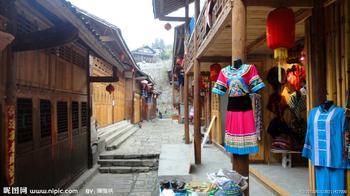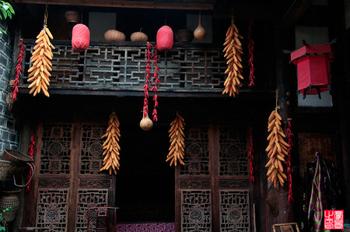Rich History Renewed

In past days, old Gongtan Town prospered as a hub of water transportation. Exploiting its natural geography, Gongtan grew rich on through-trade along the Wujiang and Apeng rivers. Later, it became a goods distribution center. Records show that at its peak, Gongtan saw annual cargo throughput surpassing five million tons.
The grandest building in Gongtan today is surely Xiqin Guild Hall, built by Shaanxi businessman Zhang Pengjiu in the late 19th century. At the time, the town was home to a salt trade office set up by the Sichuan General Administration of Salt. As an essential living food, salt had from time to time played the role of currency in the region. It was quite common, for instance, to leave a quantity of salt as payment for a meal in restaurants. Gongtan, as a “center of salt,” was an important town in Chongqing and adjoining Guizhou and Hunan provinces.
Another scenic spot is the Yard of the Ran, a local family of note. The compound was a place of lodging for members of a local trade brotherhood in the first half of the 20th century. Today it is used by many film studios as a set.
On my visit to the yard, I spotted a towrope lying looped in the center of a hall. On closer inspection the rope turned out to be made of thin slices of bamboo soaked with tung oil. The rope had been used for many years by local boat trackers. Pulling, or “tracking” boats across the shallows of the river using only this piece of rope, trackers’ hands had dyed it jet-black with dirt and sweat. Thank God we have engines nowadays, I thought.
The most noteworthy features of Gongtan are perhaps its bluestone street and stilted houses. The street extends roughly three kilometers, and its old stoneslabs have been trodden long enough to gain a sheen of well-polished jade. Walking down it, I felt I had stepped back in time. Out of the residences that line the street came enticing wafts of local cuisine. Occasionally one of the residences’ heavy wooden doors would creak open and an old resident would peer out, searching for someone or something. A loud slam, and the doors would close again.
I am not the only one to have fallen in love with the bluestone street. Distinguished contemporary painter Wu Guanzhong used it as his inspiration for The Ancient Street, one of his best-known ink-andwash paintings. Wu passed away in 2010, but his spirit lives on in his magnificent ode to Gongtan.
One facet of the bluestone street that particularly appeals to peace-seeking tourists is the lack of hawkers there. Street vendors jostle for business in many of China’s old-town streets; in Gongtan, however, it seems peace and quiet have scored a rare victory over commercialism. There are shops on the bluestone street, but vendors sit quietly and never shout out to customers. There was one trade center on the street, but it has long since disappeared.
Stilted Houses

Gongtan is home to the Tujia ethnic minority. The well-preserved Tujia stilted residences are an architectural standout in the town.
For 1,700 years, the Tujia people constructed their houses by the Wujiang River, and their stilted dwellings had survived along roughly two kilometers of riverbank right up until the dam construction. The original constructions were relocated to the site of the new town and today stand as they have done for over a millennium. The houses embody the unique artistic and cultural attributes of the Tujia to allow fresh air from and beautiful views of the river. Standout dwellings include Zhinü, Yuanyang and Xinhua. They are wooden constructions, but have nonetheless stood the test of time. The boards between the columns open as doors or windows, and latticework windows adorn the side that faces the river.
A typical Tujia house is built on a riverside slope, with its back standing against a hill and façade built up on stilts 20 to 30 centimeters in diameter. It would be two to three stories high and made almost entirely from wood. In New Gongtan, the relocated Tujia houses still afford visitors a panoramic view of the river. The youngest of the houses is over 100 years old.
Gongtan’s architectural splendors are one thing, but for us, the highlight of our stay was the townsfolk. Warm, friendly and always willing to give directions to us hapless tourists, we found ourselves growing jealous of the fact that they could stay on here, while we had to head back to the manic city where a smile from a stranger might be a sign of danger.
My travel companion and I were loath to leave Gongtan. On the morning we departed, the town was covered in a light drizzle; it seemed even the weather was conspiring to keep us there. We drove off, and as the town’s old stilted houses faded off behind us, I couldn’t help but think I’d never been so sad to leave a place.
